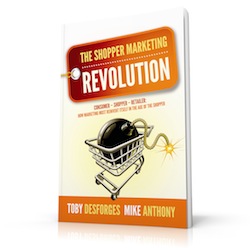 When shopper marketing first became a ‘buzz’ there were lots of people using the term consumer when they really meant shopper, and I would politely, but firmly point out the difference. After many years of beating this drum, I’d have hoped by now that the point about the shopper not being the consumer would, by now be well made, and now be part of common practice.
When shopper marketing first became a ‘buzz’ there were lots of people using the term consumer when they really meant shopper, and I would politely, but firmly point out the difference. After many years of beating this drum, I’d have hoped by now that the point about the shopper not being the consumer would, by now be well made, and now be part of common practice.
Apparently not. Whilst a couple of years ago now, in 2011, Joe Tripodi, CMO of Coca Cola: “Shopper marketing is simply a detailed understanding, culled through insights of how consumers make choices, and what they respond to”. Today on their website, Nielsen understand that their panels track shopping behavior, but they call it a ‘consumer panel’ . Whilst Wikipedia isn’t necessarily the most reliable authority, their definition of Shopper Marketing (understanding how one’s target consumers behave as shoppers…) is quoted by, amongst others, the Canadian Marketers Association and the Institute of Promotional Marketing. A google search for ‘Consumer in the store” reveals a glut of agencies who purport to be shopper marketing experts, yet still apparently haven’t got this simple distinction. It appears my 2013 prediction will almost certainly not come true
No. Shopper Marketing is not about understanding how consumers make choices. It is about understanding how shoppers make choices, and then creating a marketing mix (that’ll be a shopper marketing mix) which affects the desired changes in their behavior. Is this semantics? Far from it. Let’s explore why.
The Shopper Is Not Always The Consumer.
In every category we’ve studied, some of the people buying are not buying for themselves. Every category (and we’ve studied a lot). In many categories (toys for example) the number of shoppers who are not consumers is very high. In some markets almost half of male personal care products are bought by women. Whilst researching our upcoming book (Click here for an introductory chapter), I spoke to Hans Hallen, of Carlsberg, and in the beer category, whilst the majority of beer in the home is drunk by men, decisions about stocking up are often made by, you guessed it, women. Even in an intimate and highly personal category such as feminine hygiene, there are a small number of people buying for others (mothers and embarrassed husbands, typically). In every category the story is the same. Some shoppers are not consumers.
So what you might ask? Well… Surely as a target, someone who uses your brand must be different to someone who does not. Their experience of your brand is fundamentally different, and therefore the approach you make must be varied.
Different activities might be required
If the shopper isn’t the consumer, some of that expensive shopper marketing efforts may have a limited impact. If you want to market a new beverage in a store, then wet sampling is a great technique – get people to actually try the product there and then, and assuming its great they can buy it. But amongst shoppers who are not consumers, this tactic will be less effective. As will product consultants, who typically talk a consumer story. As a shopper I might quite like the look of a new product, but if I’m not the consumer it isn’t necessarily so that I have permission to switch to a different brand. Communication messages that are ‘consumer targeted’ can’t be directly delivered. Let’s go back to sanitary towels. How many guys here would be brave enough to go back home with a different brand because “the lady in the store recommended it” Thought not!
All of the above we know to be intrinsically true. But whilst CMOs and authorities such as Wikipedia, indulge in this lazy approximation, marketing effectiveness and efficiency will not be optimized. What happens to the money that is targeted against the “consumer in the store” but hits the “shopper who isn’t the consumer”? It is much more likely to be wasted.
No. Consumers are not the same as shoppers. They are not. Moms buy for kids. Daughters buy for granny. Husbands buy for wives. Consumer does not equal shopper. A consumer choice is different to a shopper choice. So what should a shopper marketer do about it?
Insist on accuracy
Risk being called a pedant. Insist that the word ‘Shopper” is used when talking about purchase. Politely correct the guys from the agency when they talk about consumer decisions in an in-store environment. No need for a soapbox – but do insist.
Write to Wikipedia and ask them to sort it out already
I’ve tried. Maybe if a few more people did things might get changed
Check the data
If you have data that suggests all of your consumers buy for themselves, check the sample. Often consumer research deliberately selects people who are purchase decision makers too. This therefore becomes a self-fulfilling prophecy, and proves nothing.
Check your marketing mix
Based on this, work out whether your activity requires the consumer to be present. If the consumer isn’t present in the store, can a message be sent to the consumer via the shopper (e.g. giving samples to take home rather than in-store sampling: or leaflets versus signage).
Check the mix by channel
Different shoppers will be in different channels. If one channel has lots who are buying for themselves, this might require a different marketing mix versus channels where shoppers are buying for others.
Evaluate differently
I know that many of you don’t have this type of data, but even so, you can build your thinking into the way you evaluate activities. DO certain activities require the consumer to be present? Do these work, or not work, versus activities that do not require the consumer to be in the store? Does the performance of these activities vary by channel? Create some hypotheses around this and test with future activity. Shopper data is great, but the absence of data doesn’t mean there has to be an absence of insight too.
Whilst often the consumer is the same person as the shopper, they are sometimes not. Make sure, as a shopper marketer, you are clear on who you are marketing to, otherwise you risk wasting at least some of your marketing spend.




